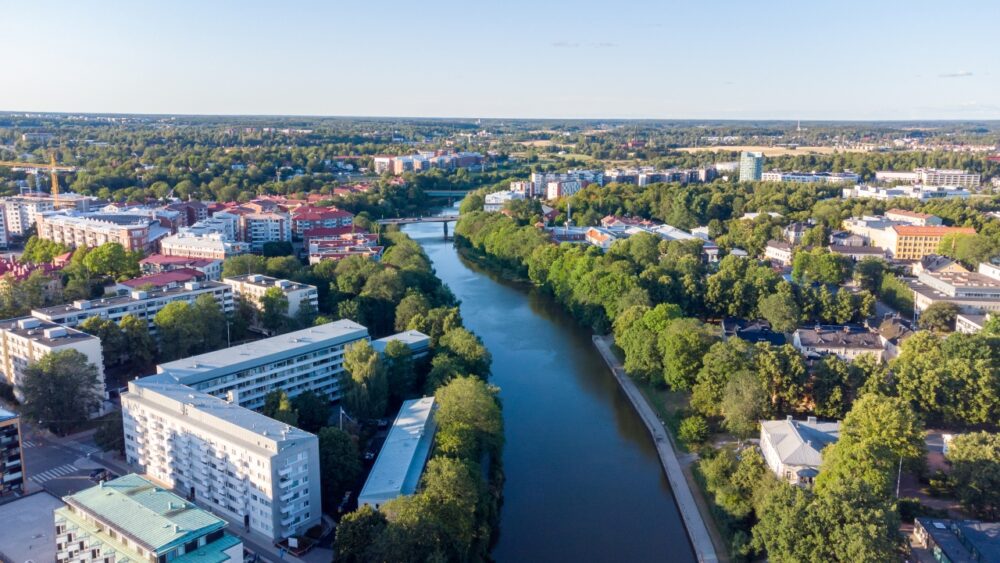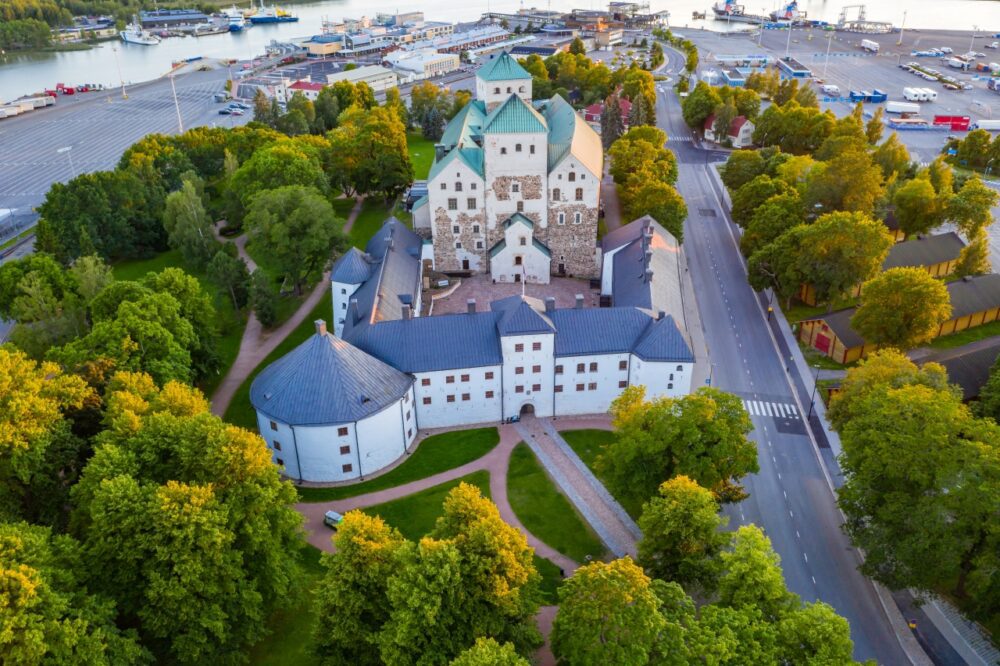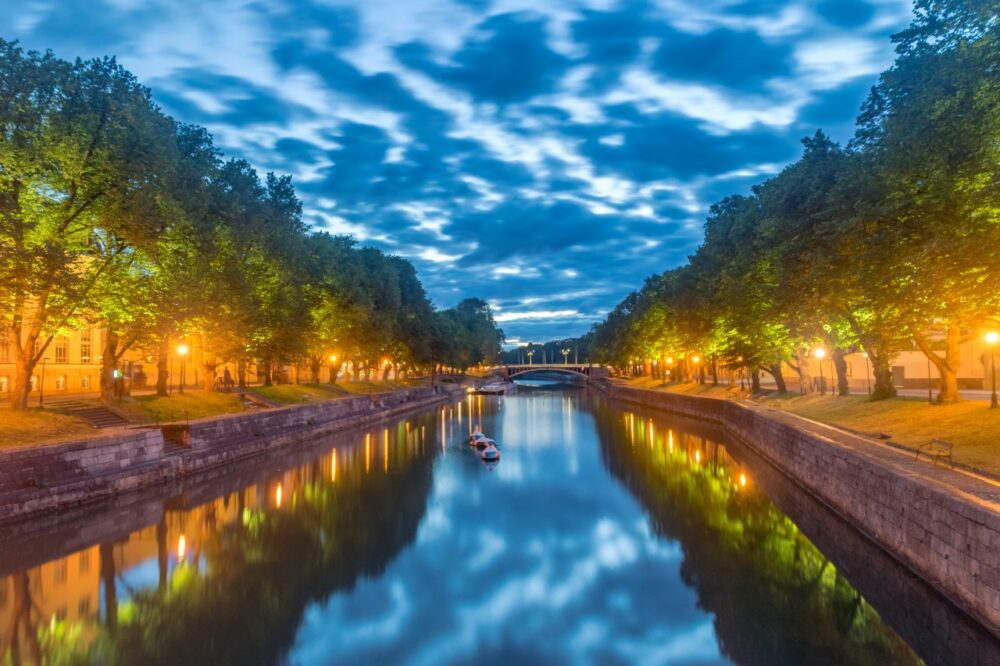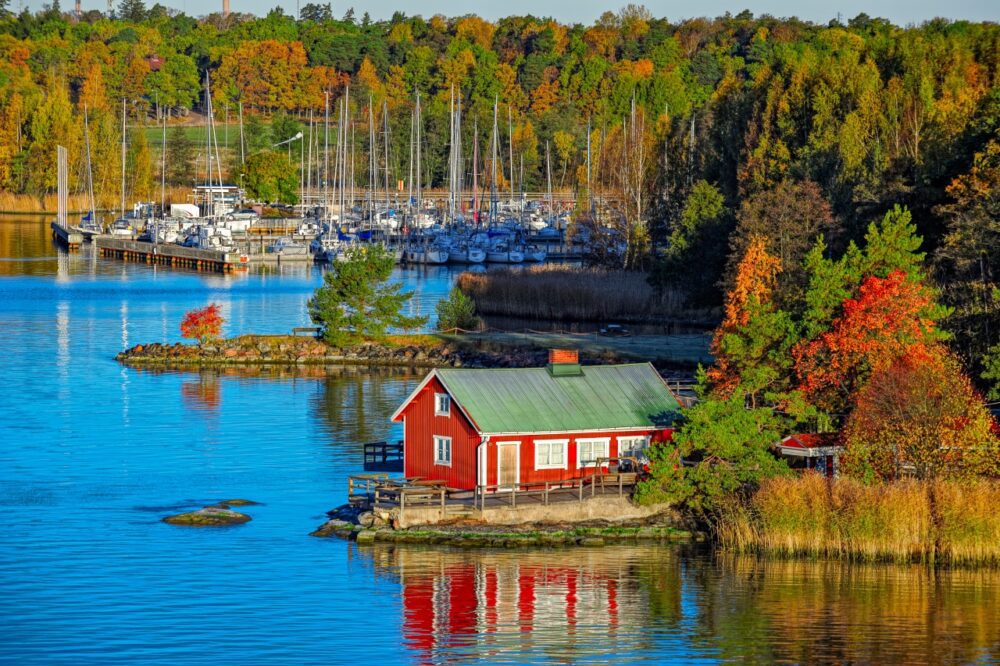
Is Turku worth visiting? Without a doubt! When I first explored Turku, Finland’s oldest city, I was struck by how effortlessly it blends history and modern charm. From strolling along the Aura River to exploring its medieval castle, Turku feels like a city that’s deeply connected to its past while embracing a creative and vibrant present.
Located on Finland’s southwest coast, Turku was the country’s capital before Helsinki, and its historic importance is evident at every turn. Whether you’re walking through the cobbled streets of the Old Town, visiting the iconic Turku Castle, or enjoying the lively restaurant scene by the waterfront, Turku offers a rich tapestry of culture and experiences. The city’s creative energy is further showcased in its festivals, art galleries, and thriving local markets. But is Turku worth visiting for you?
In this blog post, we’ll dive into the top 10 reasons why Turku should be on your travel list, from its fascinating historical landmarks to its modern attractions. Plus, we’ll share travel tips to help you make the most of your visit. Keep reading, and you’ll see why Turku is one of Finland’s most captivating destinations.
Table of Contents
Pros – Reasons You Should Visit Turku
1. A City with a Fascinating History and a Well-Preserved Old Town

Turku is Finland’s oldest city, dating back to the 13th century, and its rich history is still visible in its well-preserved landmarks and medieval charm. As the former capital, it played a key role in Finland’s development, and walking through its streets feels like stepping back in time. The city blends old and new effortlessly, with historic buildings sitting alongside modern architecture, creating a unique atmosphere that sets it apart from other Finnish cities.
One of the highlights is Turku Castle, a massive medieval fortress that has stood guard over the city for more than 700 years. Exploring its dimly lit stone corridors, grand banquet halls, and hidden chambers was like being transported into a different era. The castle’s museum does an excellent job of bringing history to life, with exhibits on everything from medieval weaponry to the lives of the nobility who once lived there. Equally impressive is Turku Cathedral, Finland’s most important church, with stunning Gothic architecture and an interior filled with centuries-old frescoes. Climbing its tower offers a great view of the city, making it a must-visit for history lovers.
2. A Beautiful Riverfront That’s the Heart of the City

The Aura River is the centrepiece of Turku, running through the heart of the city and acting as a natural gathering place for locals and visitors alike. Lined with cafés, restaurants, museums, and old sailing ships, the riverbanks have a lively yet relaxed atmosphere that makes them one of the best places to experience the city’s charm. Whether you’re enjoying a morning coffee by the water, taking a sunset stroll, or hopping on a riverboat, the Aura River gives Turku a special character that few other Finnish cities have.
One of my favourite experiences was walking along the riverside in the evening when the city lights reflected off the water, creating a magical scene. I also stopped by Café Art, a cosy riverside café known for its excellent coffee and freshly baked pastries. Sitting outside, watching people cycle past while enjoying a cinnamon bun, was one of those simple but perfect travel moments. The river also hosts events throughout the year, including the Tall Ships Races, where enormous sailing ships line the waterfront, drawing crowds from all over Finland.
3. A Thriving Food Scene with Fresh, Local Ingredients
Turku has earned a reputation as Finland’s culinary capital, thanks to its vibrant food scene and emphasis on fresh, local ingredients. The city’s restaurants range from traditional Finnish eateries to innovative modern dining experiences, making it a fantastic destination for food lovers. Whether you’re craving seafood straight from the Baltic, farm-to-table delicacies, or hearty Nordic comfort food, Turku has plenty to offer.
A must-visit is the Turku Market Hall, which has been serving locals since 1896. Inside, stalls sell everything from smoked salmon to reindeer meat and rye bread, giving visitors a taste of authentic Finnish cuisine. I tried karjalanpiirakka, a traditional Karelian pasty filled with creamy rice porridge, and it was surprisingly addictive. For a more refined dining experience, I booked a table at Kaskis, one of Finland’s top-rated restaurants, where I had an unforgettable meal featuring wild mushrooms, fresh fish, and seasonal berries. The city also has a growing craft beer and coffee scene, with many small breweries and roasteries offering locally made drinks that highlight Finnish flavours.
4. Easy Access to the Stunning Turku Archipelago

Just off the coast of Turku lies one of Finland’s most breathtaking natural attractions—the Turku Archipelago, a vast collection of over 20,000 islands scattered across the Baltic Sea. The archipelago is a paradise for outdoor lovers, offering cycling routes, hiking trails, and peaceful seaside villages where life moves at a slower pace.
I took a ferry to Nauvo, one of the larger islands, and spent the day exploring its charming harbour, lined with colourful wooden houses and small seafood restaurants. Sitting by the water, enjoying freshly caught salmon while watching boats glide past, was an experience that perfectly captured the tranquillity of the Finnish coast. For those with more time, the Archipelago Trail, a 250-kilometre cycling route connecting several islands by bridges and ferries, is one of the best ways to explore the region’s untouched natural beauty. Whether you choose to take a short boat trip or embark on a multi-day adventure, the archipelago is an unmissable part of any visit to Turku.
5. A City with a Strong Cultural Scene and Festivals All Year Round
Turku is one of Finland’s most culturally rich cities, with a wide range of museums, art galleries, and festivals that keep the city buzzing throughout the year. Whether you’re interested in history, contemporary art, or live music, there’s always something happening in Turku.
One of the most fascinating museums is Aboa Vetus & Ars Nova, which combines medieval ruins with modern art exhibitions. Walking through the underground remains of old Turku, then stepping into a contemporary art gallery in the same building, was a reminder of how seamlessly the city blends past and present. I also visited the Turku Art Museum, which has an impressive collection of Finnish art in a grand 19th-century building. If you’re visiting in summer, the city’s festivals are a major highlight. I was lucky enough to experience Ruisrock, one of Finland’s biggest music festivals, held on an island just outside the city. The mix of international artists, beautiful coastal scenery, and a laid-back Finnish crowd made it a festival experience like no other.
6. A Walkable and Bike-Friendly City
Turku is one of Finland’s most walkable cities, with a compact centre that makes it easy to explore without needing public transport. Most of the main attractions, from the castle to the cathedral to the riverside cafés, are within a short walking distance of each other. The city also has a well-developed cycling infrastructure, making biking a great way to get around.
I rented a bike for the day and cycled along the Aura River, following the scenic paths that stretch through the city. One of the best cycling routes leads to Ruissalo, a nearby island known for its beautiful nature trails and 19th-century wooden villas. The ride there was incredibly peaceful, with quiet forest paths, open fields, and views of the shimmering Baltic Sea. Whether on foot or by bike, getting around Turku is a breeze, and the lack of heavy traffic makes it even more enjoyable.
7. A Magical Destination in Winter
While many people visit Turku in summer, the city has a unique charm in winter, with snowy streets, frozen rivers, and a cosy atmosphere that makes it a perfect cold-weather destination. The highlight of the season is the Christmas Market in the Old Great Square, where wooden stalls sell festive treats, handicrafts, and mulled wine.
I visited Turku in December and was immediately enchanted by the festive atmosphere. The Christmas lights reflected off the snow-covered rooftops, the scent of cinnamon and roasted almonds filled the air, and a choir was singing traditional Finnish carols in front of the cathedral. Another special tradition is the Declaration of Christmas Peace, a ceremony held in Turku every Christmas Eve since the 1300s. Watching the city come together for this historic event, with the solemn reading of the declaration and the quiet hush of the gathered crowd, was a magical experience that made winter in Turku feel truly special.
Cons – Things to Consider When Visiting Turku
1. The Weather Can Be Unpredictable and Cold for Much of the Year
Turku, like much of Finland, experiences long, cold winters and relatively short summers. The weather can be unpredictable, even in the warmer months, with sudden rain showers and chilly evenings being quite common. Winters, on the other hand, can be harsh, with temperatures often dropping well below freezing, short daylight hours, and icy conditions that make walking around the city more difficult. While summer can bring pleasant temperatures, it is still not guaranteed to be warm, and grey, overcast days are frequent.
I visited Turku in early June, expecting mild summer weather, only to find myself caught in an unexpected rainstorm that left me shivering. One moment, the sun was out, and the next, dark clouds rolled in, bringing a downpour that lasted for hours. Even in August, the evenings were much cooler than I had anticipated, making a warm jacket essential. In winter, the cold can be even more challenging, with icy pavements and darkness setting in by mid-afternoon. While the snowy landscapes can be beautiful, the lack of daylight and freezing winds can make sightseeing less enjoyable. If you plan to visit, bringing plenty of layers, a good waterproof jacket, and sturdy footwear is essential, regardless of the season.
2. The City is Small and Can Be Seen Quickly
Turku may be Finland’s oldest city, but it is not a large one. While this makes it pleasant to explore on foot, it also means that the number of attractions is limited compared to bigger cities like Helsinki or Stockholm. Most of the main sights, such as Turku Castle, the cathedral, and the Aura Riverfront, can easily be visited in a day or two. If you are someone who enjoys packed itineraries with endless museums, landmarks, and activities, you may find yourself running out of things to do rather quickly.
On my first visit, I planned a four-day stay, thinking I would need plenty of time to explore. By the end of the second day, I had already visited the major sights and found myself slowing down just to stretch out the experience. While there are excellent day trips to the Turku Archipelago and nearby towns, the city itself does not have the same level of attractions as other European destinations. This is not necessarily a bad thing—Turku is best enjoyed at a relaxed pace—but for travellers who prefer fast-moving city breaks, it may not feel like the most exciting destination for an extended stay.
3. Limited Nightlife and Evening Entertainment
Turku has a lively student population, which keeps its nightlife scene active, but compared to larger Finnish cities, the options are quite limited. While there are some good bars, cosy pubs, and a few live music venues, the city lacks the variety and energy found in Helsinki. Many places close earlier than expected, and outside of weekends or university term time, the nightlife can feel rather subdued. If you’re looking for a city with a buzzing bar scene or late-night entertainment, Turku may not be the best choice.
One evening, I went out in search of a lively spot for drinks, only to find that many bars were either closing early or nearly empty. I did manage to find a few good places, like a small riverside pub with a great selection of Finnish craft beers, but overall, the atmosphere was much quieter than I had anticipated. Even in the summer, when the long daylight hours make the city feel alive in the early evening, things tend to slow down quite early. If you enjoy more relaxed evenings, this might not be a problem, but if you’re looking for an exciting nightlife scene, you may find Turku a little underwhelming.
4. Public Transport is Limited and Can Be Inconvenient
Turku is a very walkable city, but if you need to travel further afield, the public transport options can be somewhat limited. The city relies mainly on buses, which are reliable but not as frequent as in larger cities. Outside of the main routes, buses can be infrequent, particularly in the evenings and on weekends, making it harder to get around without a car. If you’re planning to explore the Turku Archipelago or visit smaller villages outside the city, public transport options can be even more restricted, requiring careful planning and long waiting times.
I experienced this firsthand when trying to visit one of the islands in the archipelago. The ferry schedules were limited, and the bus service to the harbour was infrequent, meaning I had to wait over an hour just to get to my destination. Even within the city, I found that some buses stopped running earlier than expected, which was inconvenient when trying to get back to my accommodation later in the evening. While taxis are available, they are quite expensive, and rideshare options like Uber are not as common as in other European cities. If you plan to venture beyond the city centre, checking bus and ferry timetables in advance is essential to avoid unexpected delays.
When to Visit Turku
The best times to visit Turku are late spring (May to June) and early autumn (September), when the weather is mild and ideal for exploring the riverfront and historic sights. These shoulder seasons offer the charm of outdoor cafes, riverside walks, and smaller crowds compared to peak summer. Summer (July and August) is Turku’s busiest season, with warm days, vibrant events like the Medieval Market and Tall Ships Races, and long daylight hours. Winter, from December to February, has a quieter, cosy atmosphere, with the city’s Christmas markets and seasonal lights creating a festive ambiance, though temperatures can be chilly.
How to Get to Turku
Turku Airport (TKU) is located about 8 kilometres from the city centre and is serviced by airlines like Finnair and Wizz Air, offering regular flights from major European cities. From the airport, you can reach the city centre by bus in about 20 minutes or opt for a taxi for a faster, direct route. If arriving from Helsinki, Turku is easily accessible by train, with VR trains making the journey in around two hours, or by bus, which takes a bit longer but is budget-friendly. Additionally, Turku is connected by ferry to Stockholm, Sweden, making it an ideal entry point for travellers coming from Scandinavia.
Where to Stay in Turku
Turku offers a range of accommodation options to suit all tastes and budgets:
- Luxury: Riverfront (Aurajoki River) – Staying along the riverfront puts you close to Turku Castle, Turku Cathedral, and a variety of restaurants and cafes. Radisson Blu Marina Palace and Solo Sokos Hotel Turun Seurahuone both offer comfortable, stylish stays with excellent views of the river.
- Mid-range: City Centre – Ideal for those who want to be in the heart of Turku’s shopping and dining areas. Original Sokos Hotel Hamburger Börs and Scandic Julia provide comfortable accommodations with convenient access to main attractions.
- Budget: Port Area – This area is a bit further from the city centre but close to the ferry terminals and well-connected by public transport. Laivahostel Borea, a former cruise ship, offers unique, budget-friendly rooms with a touch of nautical charm, perfect for those looking for an affordable stay.
Getting Around Turku
Turku’s compact layout makes it easy to explore on foot, especially around the city centre and along the scenic Aurajoki River. For longer journeys, Turku’s Föli public transport network includes buses that cover the city and surrounding areas, with single tickets and day passes available at reasonable prices. The city also has a bike-sharing system called Fölläri, which is convenient for cycling along the river or visiting attractions like Turku Castle and Ruissalo Island. For a unique view of the city, try a ferry ride along the river, especially in the summer months when boats shuttle between popular spots.
How Long to Spend in Turku
Two to three days is ideal for exploring Turku, giving you enough time to visit the main sights like Turku Castle, Turku Cathedral, and the Aboa Vetus & Ars Nova Museum. This timeframe allows you to enjoy the riverfront cafes, explore the vibrant market square, and even take a short boat trip to nearby islands. If you have more time, consider an extra day to visit Ruissalo Island for nature trails and coastal views, or to explore the Turku Archipelago, a stunning chain of islands offering a taste of Finland’s coastal beauty.
Conclusion
So, is Turku worth visiting? Absolutely! With its medieval castle, vibrant riverfront, and rich cultural scene, Turku offers an unforgettable glimpse into Finland’s history and modern life. Highlights like the Turku Archipelago, the bustling Aura River, and the charming Old Town make it a destination full of character. While it’s smaller and quieter than Helsinki, its charm and cultural richness more than make up for it. If you’re ready to discover a city where the past meets the present, start planning your trip to Turku today!
